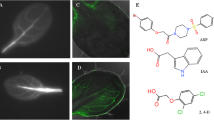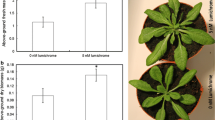Abstract
Transgenic Arabidopsis thaliana plants constitutively expressing Agrobacterium tumefaciens tryptophan monooxygenase (iaaM) were obtained and characterized. Arabidopsis plants expressing iaaM have up to 4-fold higher levels of free indole-3-acetic acid (IAA) and display increased hypocotyl elongation in the light. This result clearly demonstrates that excess endogenous auxin can promote cell elongation in a whole plant. Interactions of the auxin-overproducing transgenic plants with the phytochrome-deficient hy6-1 and auxin-resistant axrl-3 mutations were also studied. The effects of auxin overproduction on hypocotyl elongation were not additive to the effects of phytochrome deficiency in the hy6-1 mutant, indicating that excess auxin does not counteract factors that limit hypocotyl elongation in hy6-1 seedlings. Auxin-overproducing seedlings are also qualitatively indistinguishable from wild-type controls in their response to red, far-red, and blue light treatments, demonstrating that the effect of excess auxin on hypocotyl elongation is independent of red and blue light-mediated effects. All phenotypic effects of iaaM-mediated auxin overproduction (i.e. increased hypocotyl elongation in the light, severe rosette leaf epinasty, and increased apical dominance) are suppressed by the auxin-resistant axr1-3 mutation. The axr1-3 mutation apparently blocks auxin signal transduction since it does not reduce auxin levels when combined with the auxin-overproducing transgene.
Similar content being viewed by others
References
Barendse GWM, Kepczynski J, Karssen CM, Koornneef M: The role of endogenous gibberellins during fruit and seed development: studies on the gibberellin-deficient genotypes of Arabidopsis thaliana (L.). Heynh. Physiol Plant 67: 315–319 (1986).
Chaudhury AM, Letham S, Craig S, Dennis ES: ampl-a mutant with high cytokinin levels and altered embryonic pattern, faster vegetative growth, constitutive photomor-phogenesis and precocious flowering. Plant J 4: 907–916 (1993).
Chen K-H, Miller AN, Patterson GW, Cohen JD: A rapid and simple procedure for purification of indole-3-acetic acid prior to GC-SIM-MS analysis. Plant Physiol 86: 822–825 (1988).
Chory J: A genetic model for light regulated seed development in Arabidopsis. Development 115: 337–354 (1992).
Chory J, Peto CA, Ashbaugh M, Saganich R, Pratt L, Ausubel F: Different roles for phytochrome in etiolated and green plants deduced from characterization of Arabidopsis thaliana mutants. Plant Cell 1: 867–880 (1989).
Cohen JD, Baldi BG, Slovin JP: 13C6-[Benzene ring]-indole-3-acetic acid: a new internal standard for quantitative mass spectral analysis of indole-3-acetic acid in plants. Plant Physiol 80: 14–19 (1986).
Ditta G, Stanfield S, Corbin D, Helsinki D: Broad host range DNA cloning system for gram-negative bacteria: construction of a gene bank of Rhizobium meliloti. Proc Natl Acad Sci USA 77: 7347–7351 (1980).
Estelle MA, Somerville C: Auxin-resistant mutants of Arabidopsis thaliana with an altered morphology. Mol Gen Genet 206: 200–206 (1987).
Fourney R, Miyakoshi S, Day R, Paterson M: Northern blotting efficiency: RNA staining and transfer. Focus 10: 5–7 (1994).
Guzman P, Ecker J: Exploiting the triple response of Arabidopsis to identify ethylene-related mutants. Plant Cell 2: 513–523 (1990).
Hanson JB, Trewavas AJ: Regulation of plant cell growth: the changing perspective. New Phytol 90: 1–18 (1982).
Jacobsen SE, Olszewski NE: Mutations at the SPINDLY locus of Arabidopsis alter gibberellin signal transduction. Plant Cell 5: 887–896 (1993).
Jones AM, Cochran DS, Lamerson PM, Evans ML, Cohen JD: Red light regulated growth I. Changes in the abundance of indoleacetic acid and a 22-kilodalton auxinbinding protein in the maize mesocotyl. Plant Physiol 97: 352–358 (1991).
Klee H, Estelle M: Molecular genetic approaches to plant hormone biology. Annu Rev Plant Physiol Plant Mol Biol 42: 529–551 (1991).
Klee HJ, Horsch RB, Hinchee MA, Hein MB, Hoffmann NL. The effects of overproduction of two Agrobacterium tumefaciens T-DNA auxin biosynthetic gene products in transgenic petunia plants. Genes Devel 1: 86–96 (1987).
Koornneef M, Rolff E, Spruit CJP: Genetic control of light-inhibited hypocotyl elongation in Arabidopsis thaliana (L.) Heynh. Z Pflanzenphysiol 100: 147–160 (1980).
Leyser HMO, Lincoln C, Timpte C, Lammer D, Turner J, Estelle M: Arabidopsis auxin-resistance gene AXR1 encodes a protein related to ubiquitin-activating enzyme E1. Nature 364: 161–164 (1993).
Lincoln C, Britton JH, Estelle M: Growth and development of the axr1 mutants of Arabidopsis. Plant Cell 2: 1071–1080 (1990).
Liscum E, Hangarter R: Arabidopsis mutants lacking blue light-dependent inhibition of hypocotyl elongation. Plant Cell 3: 385–694 (1991).
McCormac AC, Cherry JR, Hershey HP, Vierstra RD, Smith H: Photoresponses of transgenic tobacco plants expressing an oat phytochrome gene. Planta 185: 162–170 (1991).
McCormac AC, Wagner D, Boylan MT, Quail PH, Smith H, Whitelam GC: Photoresponses of transgenic Arabidopsis seedlings expressing introduced phytochrome B-encoding cDNAs: evidence that phytochrome A and phytochrome B have distinct photoregulatory functions. Plant J 4: 19–27 (1993).
Robson PRH, Whitelam GC, Smith H: Selected components of the shade-avoidance syndrome are displayed in a normal manner in mutants of Arabidopsis thaliana and Brassica rapa deficient in phytochrome B. Plant Physiol 102: 1179–1184 (1993).
Rogers SG, Klee HJ, Horsch RB, Fraley RT: Improved vectors for plant transformation: expression cassette vectors and new selectable markers. Meth Enzymol 153: 253–277 (1987).
Romano CP, Cooper ML, Klee HJ: Uncoupling auxin and ethylene effects in transgenic tobacco and Arabidopsis plants. Plant Cell 5: 181–189 (1993).
Romano CP, Hein MB, Klee HJ: Inactivation of auxin in tobacco transformed with the indoleacetic acid-lysine synthetase gene of Pseudomonas savastanoi. Genes Devel 5: 438–446 (1991).
Schena M, Lloyd AM, Davis RW: The HAT4 gene of Arabidopsis encodes a developmental regulator. Genes Devel 7: 367–379 (1993).
Shinkle JR, Briggs WR: Physiological mechanism of the auxin-induced increase in light sensitivity of phytochromemediated growth responces in Avena coleoptile sections. Plant Physiol 79: 349–356 (1985).
Smith H, Whitelam GC: Phytochrome, a family of photoreceptors with multiple physiological roles. Plant Cell Environ 13: 695–707 (1990).
Somers DE, Sharrock RA, Tepperman JM, Quail PH: The hy3 long hypocotyl mutant of Arabidopsis is deficient in phytochrome B. Plant Cell 3: 1263–1288 (1991).
Talon M, Koornneef M, Zeevaart JAD: Accumulation of C19-gibberellins in the gibberellin-insensitive dwarf mutant gai of Arabidopsis thaliana (L.) Heynh. Planta 182: 501–505 (1990).
Thomas B, Dickinson HG: Evidence for two photoreceptors controlling growth in de-etiolated seedlings. Planta 146: 545–550 (1979).
Valvekens D, VanMontagu M, VanLusebettens M: Agrobacterium tumefaciens-mediated transformation of Arabidopsis thaliana root explants by using kanamycin selection. Proc Natl Acad Sci USA 85: 5536–5540 (1992).
Whitelam GC, Harberd NP: Action and function of phytochrome family members revealed through the study of mutant and transgenic plants. Plant Cell Environ 17: 615–625 (1994).
Whitelam GC, Smith H: Retension of phytochrome mediated shade avoidance responses in phytochromedeficient mutants of Arbidopsis: cucumber, and tomato. J Plant Physiol 139: 119–125 (1991).
Yang T, Law DM, Davies PJ: Magnitude and kinetics of stem elongation induced by indole-3-acetic acid in intact light-grown pea seedlings. Plant Physiol 102: 717–724 (1993).
Author information
Authors and Affiliations
Rights and permissions
About this article
Cite this article
Romano, C.P., Robson, P.R.H., Smith, H. et al. Transgene-mediated auxin overproduction in Arabidopsis: hypocotyl elongation phenotype and interactions with the hy6-1 hypocotyl elongation and axr1 auxin-resistant mutants. Plant Mol Biol 27, 1071–1083 (1995). https://doi.org/10.1007/BF00020881
Received:
Accepted:
Issue Date:
DOI: https://doi.org/10.1007/BF00020881




